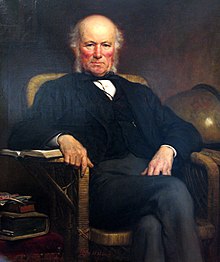William Pengelly
William George Pengelly (born January 12, 1812 in East Looe , Cornwall , † March 16, 1894 ) was a British geologist , paleontologist and prehistorian . He was one of the pioneers in speleology and prehistoric archeology in England. Mostly self-taught and a private tutor, he promoted local education in his native Devonshire and researched its geology.
Life
William Pengelly was the son of a captain, and Pengelly himself went on his father's ship as a cabin boy when he was twelve . As a teenager, he continued his autodidactic training and opened a school in Torquay in 1836 , where he taught using the Pestalozzi method . Although the school was successful, he gave it up in 1846, became a private tutor and otherwise devoted himself to the sciences, especially geology, paleontology and archeology. In 1849 he published a first scientific paper on a fossil fish found in Cornwall. He founded the Torquay Young Men's Society (later Torquay Mechanics School ), the Torquay Natural History Society and in 1862 the Devonshire Association for the Advancement of Literature, Science, and Art, which later became the Devonshire Association . There he also gave lectures and taught. He carefully kept notes of his extensive wanderings to explore the geology of his homeland. He gave lectures, for example, in Newcastle-on-Tyne , Norwich and Exmouth , corresponded a lot and taught both ordinary people and high foreign nobles.
plant
In 1858 he dug in a newly discovered cave (Windmill Hill Cavern near Brixham ) (according to a plan developed with the geologist Hugh Falconer and under the supervision of the Royal Society and the Geological Society of London). John Evans and Joseph Prestwich were also involved . The excavations lasted around a year under his supervision and he was very precise, paid attention to precise documentation of the sites and worked layer by layer, which was completely new at the time. There he was able to unequivocally date a human artifact (a flint tool) as coexisting with extinct animals such as the woolly rhinoceros and the cave lion (the finds were under a stalactite layer). These were some of the early arguments against the then still popular notions of the chronology of the Bible. They also went public (1859) and Pengelly corresponded with Charles Darwin about it .
In 1860 he examined the tertiary brown coal ( lignite ) of Bovey Tracey , which he proceeded as carefully as in his caving. The fossil plants were determined by Oswald Heer .
His reputation as a very precise excavator gave him the task of continuing the excavations of the clergyman John McEnery in the cave of Kents Cavern , who had made prehistoric finds there in 1865 . This became the main business of his life, which he carried on until 1880 (supported by the British Association). He also dug in other caves in Devon. He published his results mostly in the Transactions of the Devonshire Association .
His research was essential in convincing leading British scientists (including Charles Lyell , Joseph Prestwich , Richard Owen ) of the old age of humans in the sense that prehistoric humans coexisted with animals that are now extinct in Europe. The French Boucher de Perthes had already made similar finds in the river terraces of the Somme (published in 1847), but this made little impression in England. Essential for the acceptance of Pengelly's discoveries in 1858/59 were his exact scientific excavation methods, which he introduced into prehistoric archeology and cave research, with which he also convinced skeptical scientists up to then.
Honors and memberships
In 1863 he became a Fellow of the Royal Society . He was also a Fellow of the Geological Society of London (1850). He regularly attended meetings of the British Association for the Advancement of Science . In 1886 he received the Lyell Medal and in 1877 the Lyell Geological Fund.
Private
In 1838 he married his cousin Mary Ann Mudge, with whom he had three children, and again after her death in 1851. In his second marriage to Lydia Spriggs, he had two daughters, Lydia and Hester, of whom the younger wrote his biography and became a writer. She married the mining engineer Henry Forbes Julian, who died in 1912 in the sinking of the Titanic .
Fonts (selection)
- On the ichthyolites of East Cornwall. In: Transactions Royal Geological Society Cornwall, Volume 7, 1849/50, pp. 106-108, 115-120.
- with Oswald Heer : On the Lignite Formation of Bovey Tracey, Devonshire. Taylor and Francis, London 1863 ( Archives )
- Report on the Exploration of Brixham Cave, Conducted by a Committee of the Geological Society, and under the Immediate Superintendence and Record of Wm. Pengelly, Esq., FRS, Aided by a Local Committee; with Descriptions of the Organic Remains by G. Busk, Esq., FRS, and of the Flint Implements by John Evans, Esq., FRS, In: Proceedings of the Royal Society, Vol. 20, 1871, pp. 514-524, Archives
literature
- Hester Pengelly: A memoir of William Pengelly, of Torquay, FRS, geologist, with a selection from his correspondence. John Murray, London 1897, edited by his daughter ( Archives )
- WB Dawkins : William Pengelly. In: Nature 49, 1894, pp. 536-537.
- S. Baring-Gould : Cornish characters and strange events. John Lane, London, New York, 1909 ( Archives )
- William Pengelly, FRS 1812-1894. In: Studies in Speleology 1, 1964, pp. 3-8.
- Jacob Gruber: Brixham Cave and the Antiquity of Man. In: ME Spiro (Ed.): Context and Meaning in Cultural Anthropology 1965
- Michael J. Bishop: Pengelly, William (1812-1894) . In: Oxford Dictionary of National Biography , Oxford 2004
Web links
| personal data | |
|---|---|
| SURNAME | Pengelly, William |
| ALTERNATIVE NAMES | Pengelly, William George |
| BRIEF DESCRIPTION | British geologist, paleontologist and prehistorian |
| DATE OF BIRTH | January 12, 1812 |
| PLACE OF BIRTH | East Looe |
| DATE OF DEATH | March 16, 1894 |
